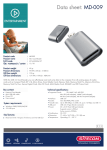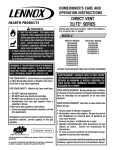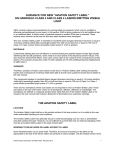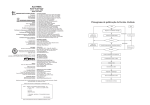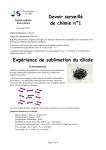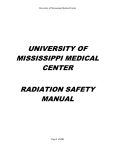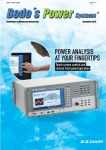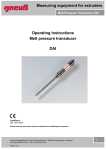Download Radiation Oncology Workload Measurement Tool Development
Transcript
Radiation Oncology Workload Measurement Tool Development Final Report University of Michigan Health System Department of Radiation Oncology: Marc Halman, Director of Administration Program & Operations Analysis Department: Mary Duck, Management Systems Coordinator Student Team, University of Michigan Industrial & Operations Engineering: Brad Barker Troy Brinlcman Jim Denner Heather White April 26, 2004 Table of Contents EXECUTIVE SUMMARY ii INTRODUCTION GOALS AND OBJECTIVES BACKGROUND SCOPE PROJECT APPROACH Phase 1: Collected Data Phase 2: Analyzed Data Phase 3: Develop Recommendations FINDINGS Literature Search Interviews Flowcharts Data Collection Dosimetry Physics Treatment CONCLUSIONS RECOMMENDATIONS ACTION PLAN 1 1 1 3 3 3 4 5 5 5 6 6 7 7 9 11 APPENDIX A: FLOWCHARTS 1 Patient Consult 2.1 Treatment Planning 2.2 Dosimetry Treatment Planning 2.2a Dosimetry Treatment Planning 3.1 Physics Treatment Planning 3.2a Physics Quality Assurance Measurement 3.2b Physics Quality Assurance Evaluation 3.3c Physics Quality Assurance Analysis — — — - — — — APPENDIX B: DATA COLLECTION SHEETS 1 Dosimetry 2 Physics 3 Treatment — — — APPENDIX C: WORKLOAD MEASUREMENT TOOL 12 13 13 19 19 20 21 22 23 24 25 26 27 27 28 29 30 EXECUTIVE SUMMARY The University of Michigan Health System (TJMHS) houses one of America’s most technologically advanced Radiation Oncology departments. As such, the Radiation Oncology department constantly stands on the cutting edge of new developments in radiation therapy. The most recent development instituted at UMHS is Intensity Modulated Radiation Therapy (IMRT). This study was commissioned to study the workload for IMRT and compare it to standard therapy workload, which includes two-dimensional and three-dimensional therapies. The study began January 6, 2004 and ended on April 22, 2004. Tn particular, the project team studied the Dosimetry, Physics, and Therapy processes. Radiation Oncology currently lacks a consistent method for quantifying workload for any radiation therapy. The purpose of this study was to develop a tool for correlating Dosimetry, Physics, and Therapy workload to treatment type. The primary goal was to develop a method for measuring this relationship and to create a tool that would allow Radiation Oncology to continue such measurements. This study’s scope included the Radiation Oncology department at UMHS in Ann Arbor, MI. Furthermore, it included standard therapy and IMRT only, focusing on Dosimetry, Physics, and Treatment. The study did not include any other methods of radiation therapy and did not include studies of other UMHS satellite treatment centers. The project was divided into three phases: Phase 1 Collected data Tasks Conducted literature search; conducted 8 interviews; observed Dosimetry, Physics, and Treatment processes; developed process flowcharts, created and distributed data collection sheets Duration 21 days 2 Analyzed data Collected data collection sheets and studied results, created visual representations of data, discussed findings and developed conclusions 21 days Developed recommendations Use data to make recommendations and develop a method for implementing recommendations 14 days — 3 — — The conclusions in this paper are based on findings from interviews, observations, literature searches, and data collection. Interviews with staff in Dosimetry, Physics, and Therapy gave the project team perceptions of how IMRT is executed. It was noted that 11VIRT computer calculations increase from three seconds to one hour in Dosimetry. For Physics, quality assurance increases from ten minutes to ten hours. Treatment itself increases from an average of twenty minutes to forty, according to interviews. The literature search helped to verify these perceptions. A study done at the University of Florida measured that treatment planning (includes both Dosimetry and Physics) takes about eight hours for IMRT, which is double that for 3D therapy and four times more than 2D therapy. Radiation Oncology Workload Measurement Tool Development Program & Operations Analysis, UMMC Page ii April 26, 2004 The team observed the individual processes to gain a better understanding of them after conducting interviews. Detailed flowcharts were created to visually depict the process. Members of Radiation Oncology staff verified the flowcharts’ accuracy and the flowcharts were then used to create data collection sheets. The data collection sheets were distributed and total sample size for this project was 73, including samples for standard therapies and TMRT. This sample size is sufficient to draw trends, but insufficient to use as final standards. The table below summarizes the results from the sheets, giving an overview of the difference in workload of IMRT compared to standard therapy: Process Dosimetry Physics Treatment 2D Therapy (mm) 55 10 16.8 3D Therapy (mm) 199 10 16.7 IMRT (mm) 635 430 32.3 The main cause of increased time for Dosimetry is treatment planning. Almost three quarters of the Dosimetry process time is computer time including point calculations and optimization. Only 25% of the planning Dosimetry process time is Dosimetrist effort time. Physics process time increases because of the extensive quality assurance required for JIVIRT. Physicists spend over an average of two hours taking and developing films which are used to verify that the treatment is given to the patient precisely as planned. Treatment for 1MRT takes almost twice as long as standard therapy. All of the IMRT cases studied were tumors in the head and neck area. These patients are severely uncomfortable during treatment and often have to request a break. Therefore, the fact that IMRT takes longer is confounded with the nature of the treatment’s purpose. However LMRT of other body sites may have different results. — The project team developed a Workload Measurement Tool which will provide the mean person-minutes per case for Dosimetry, Physics, and Treatment. This tool will allow the department to predict the total workload for each of these areas based on the expected volume of cases. IJMHS can continue to take data and eventually reach a significant sample size. To have 95% confidence that the mean person-hours is within the range of +1- 15 minutes, 285 more samples of Dosimetry are needed, 48 more samples of Physics data are needed, and 16 more samples of Treatment data are needed. It will take approximately one year to collect the Dosimetry and Physics data at this level of confidence if an average of one sample of Dosimetry and five samples of Physics are collected per week. The project team recommends that the Radiation Oncology department continue to take data of the Dosimetry, Physics, and Treatment processes for standard therapy and IMRT therapies. Using the Workload Measurement Tool, the department can predict the workload for Dosimetry, Physics, and Treatment based on their projected volume. They can use this tool as new methods of therapy are introduced into the department. We also recommend that Radiation Oncology determine the root cause of increased time IMRT. Although many of the additional processing times are inherent because of the for newness of IMRT, there may be controllable factors that contribute to increased time. Radiation Oncology Workload Measurement Tool Development Program & Operations Analysis, UMMC Page iii April 26, 2004 INTRODUCTION The University of Michigan Health System (LTMHS) has one of the country’s most reputable and technologically advanced Radiation Oncology departments. To implement advancements in technology, IJMHS must maintain up-to-date procedures and understand workload requirements. Currently, there is no model used for any method of resource planning for radiation therapy. As a result, when new technologies are introduced in Radiation Oncology, there is no quantification of how the changes will affect the workload. The Radiation Oncology department recently implemented Intensity Modulated Radiation Therapy (LMRT) and needs a method for determining the necessary staff resources needed for IMRT as the volume of cases treated with this method increases. The staff resources this project focused on are: Dosimetrists, Physicists, and Therapists The purpose of this project was to study Dosimetrist, Physicist, and Therapist workload for both standard therapy and IMRT, and ultimately develop a way to relate the condition of a patient’s treatment to the staffing resources needed. An accurate workload model was developed based on data collected in this study as well as in previous studies. Additionally, the project team created a Workload Measurement Tool that Radiation Oncology can use to determine resources needed on an ongoing basis. GOALS AND OBJECTIVES To create a tool for measuring staff workloads, the following objectives were identified and met during the project: • • • Develop a method for quantifying Dosimetrist, Physicist, and Therapist workload Create a tool for measuring and updating workload as new technologies are implemented Study the relationship between workload for standard therapy and IMRT The student team first met with the project coordinator on Thursday, January 22, 2004, data analysis ended on Thursday, April 22, 2004. During the data collection period of the project, the team was unable to obtain a sufficient sample size. The team developed a Workload Measurement Tool which can be used to complete the data collection and offer a method for collecting workload data for any future therapy. BACKGROUND Standard radiation therapy refers to two types of therapy: two-dimensional and threedimensional. Two-dimensional (2D) therapy treats tumors on two axes. Three-dimensional (3D) therapy uses three axes, and treats a tumor from 10 to 12 angles. Standard radiation therapy has the following disadvantages, according to perceptions of Radiation Oncology: • • Convex (complex-shaped) tumors are difficult to treat Non-cancerous tissues can be subject to radiation Radiation Oncology Workload Measurement Tool Development Program & Operations Analysis, UMMC Page 1 April 26, 2004 Thus, the Radiation Oncology department has introduced Intensity Modulated Radiation Therapy. IMRT uses computer optimization to develop treatment plans in which a tumor can be treated on three axes, from up to 100 angles. LMRT also uses a multi-leaf collimator (MLC) which is part of the treatment equipment. The MLC contains moving leaves that dynamically change shapes during treatment so the radiation beam can be modulated while the beam is on. IMRT is preferred for the following reasons: • • • Complex-shaped tumor are easier to treat Sensitive tissues surrounding the tumor are spared Less dosage is needed in increased number of beams However, the IMRT treatment method is perceived to be time-consuming, with a processing time up to ten times greater than that of standard treatments based on perceptions of Dosimetrists and Physicists. Specific tasks in which additional time is required for 1MRT are Treatment Planning, Quality Assurance (QA), and Treatment. Table 1 gives a detailed definition of these tasks, as well as the staff involved who performs the task. Table 1: Key Task Definitions Staff Process Treatment Therapist Treatment Planning Dosimetrist Quality Assurance Physicist Definition Physical use of radiation on patient, begins with room set-up and ends with clean-up Definition of tumor and normal tissue volumes, calculation of dosage, optimization of radiation in areas of tumor Verification of accurate treatment delivery as compared to planned delivery Compared to standard therapy, the time required to complete the IMRT-related tasks listed above is perceived to increase by up to sixty times. However, complexity and tumor location also cause increases in process times, regardless of what therapy is used. Location refers to the physical location of a patient’s body where radiation is administered. Complexity, for this study’s purpose, is measured in number of ports, segments, and fields. Table 2 defines these units. Table 2: Definition of Complexity Terms Measurement of Complexity Port Segment Field Definition The containment of one radiation beam Division of a port, intense ports can be broken into two segments Three-dimensional axis of a beamlet An increase in number of ports, segments, and fields is used to spare sensitive, non-cancerous tissue by focusing more angles of beams of less dosage on a tumor. Non-cancerous tissues like the brain, spinal chord, and parotid gland, if affected, reduce quality of life following treatment. IMRT and 3D therapies make a particular attempt to avoid these tissues, hence the increase in demand for each. Radiation Oncology Workload Measurement Tool Development Program & Operations Analysis, UMMC Page 2 April 26, 2004 According to a Physicist, UMHS handled 11 IMRT cases from January through December in 2003. The Manager of Operations, projects an increase to 145 cases in fiscal year 2005, beginning in July 2004. This anticipated acceleration in demand for IMRT was the motivation for this project. SCOPE The scope of this project consisted of the department of Radiation Oncology department of the University of Michigan Health Systems in Ann Arbor. Only standard and IMRT therapies were studied. In particular, the workload for Dosimetry, Physics, and Therapy were quantified. Figure I outlines this scope. Ann Arbor, MI UMHS Standard & IMRT Therapy Workload for: Dosimetry Physics Therapy Figure 1: Project Scope In addition to quantifying these specific workloads, the project team developed a Workload Measurement Tool relating projected number of cases (per therapy type) and staff resources required. Radiation techniques such as brachytherapy and gamma knife were not included in this study. Branches of UMHS in Providence, Novi, Jackson, Alpena, and Lansing were not studied. Also, workload for Physicians was not directly quantified and was not included in the model. PROJECT APPROACH This project was performed in three phases: Data Collection, Data Analysis and Recommendations. Details of these phases are outlined below. Phase 1: Collected Data. The project team investigated various sources of data to determine the current practices radiation therapy, both within and outside of UMHS. The following is a list of the tasks completed in this phase: • • • Reviewed existing data staffing models at other hospitals Conducted a literature search Interviewed two Dosimetrists, two Physicists, one Therapist, two Physicians, and one Resident Physician Radiation Oncology Workload Measurement Tool Development Program & Operations Analysis, UMMC Page 3 April 26, 2004 • • • • Observed one Physicist, one Therapist, and one Resident Physician as they performed the tasks being studied Created flowcharts for major processes within Radiation Oncology Developed data collection sheets Distributed data collection sheets to Dosimetrists, Physicists, and Therapists The Radiation Oncology department provided sources for benchmarking and the project team conducted additional literature searches on the Internet. The team conducted interviews with staff suggested by the client, and consisted of questions to further the project team’s understanding of the radiation therapy processes. Observations were of similar nature to interviews, and included detailed explanations of processes concurrent with tours and walk throughs of the staff’s routines. Observations and interviews provided information for flowcharts that were reviewed between the project team and Radiation Oncology staff. (See Appendix A). The flowcharts depicted the overall process of therapy and these processes were captured in detailed data collection sheets. The collection sheets, in addition to the processing time, took into account various factors such as: CPI # (corporate patient identifier), date, visit number, machine number, number of ports, fields, and segments, as well as spaces for multiple iterations. (See Appendix B). The data collection sheets were distributed to Dosimetry, Physics, and Therapy staff. The staff collected data for 21 working days. Data that was not properly captured or data that was not captured at all will be accounted for in the Workload Measurement Tool introduced later in this report. Phase 2: Analyzed data. Data collection sheets were collected as soon as they were filled out by the staff. The project team entered the data and used statistical as well as graphical tools to analyze the data. The following are the major steps involved with Phase 2: • • • Updated and distributed data collection sheets when additional or different data was needed Created graphs and visuals of the current process Statistically analyzed the data collected from data collection sheets The purpose of the data analysis was to investigate the total process time for Dosimetry, Physics, and Therapy. The project team used Microsoft Excel to compare the total time for each of these three staffing areas for standard therapy and IMRT. Furthermore, the data showed how this time was related to various aspects of the treatments such as the complexity (marked by number of ports, fields, and segments) and tumor location. Table 3 below shows the breakdown of samples collected for each of the therapies. Table 3: Number of Samples Collected Process 2D Therapy 3D Therapy IMRT 2 0 4 8 0 31 6 4 17 Dosimetry Physics Treatment Radiation Oncology Workload Measurement Tool Development Program & Operations Analysis, UMMC Page 4 April 26, 2004 Phase 3: Developed Recommendations. The project team used the data from Phase 2 to develop conclusions and then recommendations based on these. An implementation plan and user’s manual were also developed for the Workload Measurement Tool. FINDINGS The results of “Phase 1: Data Collection” are described below in detail and represent the current state of UIVIHS’s Radiation Oncology department. Literature Search The project team consulted a study conducted by Palta & Ritz at the University of Florida in 2003 titled, “Radiation Oncology Physics Staff Variable Workload Estimating Worksheet.” The study investigated the various contributions to workload for standard therapy and IMRT. Although the team’s client advised that this study was in more detail than was necessary for this project, the project team used the study for benchmarking. Figure 2 shows one result from Palta and Ritz’s study: the mean time per procedure for treatment planning for 2D and 3D therapies and IMRT. 10 8 1 IMRT 3-D 2-D Source: Palta & Ritz, “Radiation Oncology Physics Staff Variable Workload Estimating Worksheet April16, 2003 Figure 2: Treatment planning takes longer for IMRT than for standard therapy The chart shows that IMRT takes almost twice as long to plan as standard therapy does. The project team had limited access to this study and could not specify what was included in “treatment planning” at the University of Florida. A physicist from UMHS’s Radiation Oncology department attended a conference held at St. Agnes Cancer Center in Baltimore Maryland. A presentation given there described the changes required to implement IMRT at a hospital. Although UMHS has already instituted many of these Page 5 Radiation Oncology Workload Measurement Tool Development 26, 2004 April Program & Operations Analysis, UMMC changes, St. Agnes suggested that two new cases per week of IMRT requires 0.5 1 FTE. This is useful information for TJMHS as they plan to undertake three new cases of IMRT per week in fiscal 2005. Additionally, the time required for treatment planning and quality assurance for IMRT is two to ten times that of standard therapy. — Interviews Interviews were held with various staff members at UMHS which helped the project team understand the radiation therapy process as well as to quantify the department’s current practice. Table 4: Perceived process times are longer for IMRT than for standard therapy Process Standard IMRT Dosimetry 3 seconds 1 hour QA 10 minutes 10-12 hours Treatment 10-20 minutes 45 minutes Additionally, UMHS currently accepts only 1-2 new patients per week using IMRT because of the constraints the method imposes on the staff resources. Interviews as well as observations also demonstrated that there are processes within Dosimetry, Physics, and Treatment that are not standardized. Lack of standardization is due to variation in patient situation. In more than one interview, subjects addressed the issue of down time due to computer calculations. This included waiting for calculations, waiting for downloads, and searching for files. Flowcharts Radiation Oncology staff walked through their individual processes with the project team. Dosimetrists, Physicists, and Therapists interact in a way that was captured using multiple flowcharts. The level of detail in these flowcharts is included so that the team would understand the process and be able to create data collection sheets based on it. The total process is represented in Figure 3. Figure 3: Observed total treatment process Patient consultation, treatment planning, and treatment all have detailed flowcharts in Appendix A. Radiation Oncology Workload Measurement Tool Development Program & Operations Analysis, UMMC Page 6 April 26, 2004 Data Collection Information from the flowcharts was used to create data collection sheets that would give multiple measurements of process times for Dosimetry, Physics, and Therapy. The data collection sheets are in Appendix B. Data was collected for approximately six weeks. The findings are outlined below categorized by process: Dosimetry Findings An example of the Dosimetry Data Collection Sheet can be found in Appendix B-i The total Treatment Planning process was dissected into seven individual processes. These seven processes were formed after original data collection. The Dosimetrists identified distinct processes as being Contouring, Alignment, Expansion, Reviewing Volumes, Planning, Plan Approval and VARIS Transfer. To simplify the collection sheet, minor processes were merged into previously mentioned processes. Some examples of minor processes are listed in Table 4. Table 4: Merging Minor Processes into Distinct Processes Minor Processes Merged Distinct Process Contouring Planning Plan Approval VARIS Transfer Enter Normal Tissues, Enter Tumor Volume Point Calculations, Optimizing Costs Scripting MUT Calculations, DRR’s, Vision, Charting The Dosimetrists wrote down the start and end times of each process. A total process time was then calculated from the difference between the two. The total times were then added together and an average time for Treatment Planning was calculated. Figure 4 shows that IMRT requires more time for IMRT than it does for standard therapy. The graph represents average total time for the Dosimetrist to plan. 700 600 500 UI I IMRT 635 MIN 400 3D 199 MIN 300200 i00 2D 55M1N 0 Figure 4: Dosimetry takes longer for IMRT than for standard therapy Radiation Oncology Workload Measurement Tool Development Program & Operations Analysis, UMMC Page 7 April 26, 2004 As Figure 4 shows, the calculation of dose requires an average of 635 minutes for an IMRT patient, which is more than three times the time required of 3D (199 minutes) and 11 times that of 2D therapy (55 minutes). One reason for this increase is the time necessary for the computer to do optimization calculations. For the Treatment Planning process, a Dosimetrist enters required data and waits for the computer software to calculate dose for IMRT. This wait time is generally done overnight, while there is no Dosimetrist doing work for the patient. Figure 5 shows how much of planning time is used waiting for computer calculations. 195 MIN. COMPUTER 495 28%OF TOTAL MIN. 72%OF TOTAL Figure 5: Planning: Computer Calculations Exceed Effort Time of Dosimetrist Clearly, much time of the Planning process of the Dosimetrists is waiting for computers. In fact, almost three out of every four minutes of planning time are spent waiting. Of the seven distinct processes that make up Dosimetry Treatment Planning, two are characterized by computer interaction. These are “Planning” and “VARIS”. Figure 6 shows that these two processes require more time for IMRT than for standard therapies. Specifically, Planning takes almost 200 minutes for IMRT, whereas 3D and 2D therapies require roughly 80 and 10 minutes, respectively. The 250% increase can be attributed to standard therapy’s independence of additional computer time. 250 E12DL13D!IJ \(Q\S G Figure 6: Dosimetry individual process time is affected by JMRT Radiation Oncology Workload Measurement Tool Development Program & Operations Analysis, UMMC Page 8 April 26, 2004 The increase in time required for Contouring should be noted. For JMRT and 3D, Contouring takes 43 and 36 minutes, respectively. This process only takes 15 minutes for 2D therapy. Additionally, Alignment and Expansion are not always done. Physics Findings Because IMRT is a new process at IJMHS and commercial software is not used, Quality Assurance is much more rigorous for IMRT than for standard therapy. Standard therapy is more established and QA is only composed of manually checking VARIS and the accuracy of data transfers. This process was estimated by a Physicist to take about 10 minutes. A maximum time of 15 minutes was given to the team. Hence, only IMRT was studied. The Quality Assurance process for Physicists was studied similar to Dosimetry’s Treatment Planning. A sample data collection sheet can be found in Appendix B-2. The major processes of Quality Assurance were obtained from interviews and observations. Table 5 is a list of these processes. Table 5: QA Processes [Process QA Setup Run Standard QA QA Fields Setup Conduct Ion Chamber Readings Check Measurement Results Setup for Filming Process Take Films/Record Dynalogs Prepare Films for Analysis Convert Films to UMPlan Create H&D Curve Analyze Films Create Dose Plots Analyze Dynalogs Just as the Dosimetry collection sheet was revised, the QA data collection sheet was revised after one week of collection in order to obtain more accurate data. The Physicist recorded start and end times for the processes listed in Table 5, in addition to time spent for any non-standard communication. The start and end times were used to calculate a total time for each specific activity, then these total times were added together to accumulate a total time for the entire QA process. Figure 7 compares the total QA time for IMRT to the estimated time of 10 minutes for standard therapy. Radiation Oncology Workload Measurement Tool Development Program & Operations Analysis, UMMC Page 9 April 26, 2004 500 450 400 Ui - 350 IMRT 430 MIN 300 Ui 250 200 - -j 150 0 i_. 100 50 Standard 10 MIN - - 0 Figure 7: Average QA Process Time: IMRT vs. Standard Quality Assurance requires an average 430 minutes to complete for IMRT, which is about 43 times that of standard therapy. It is important to reiterate that QA for IMRT is much more rigorous than for standard because of its recent installation and because of the nature of the IMRT process. Physicists and the Director of Administration have projected that once the Radiation Oncology Department of UMHS becomes more experienced and the new equipment and software have proven its validity, the QA process could become less rigorous. Also, the numbers in Figure 7 do not include work done by the Chief Physicist. The workload of the Chief Physicist would add approximately 150 minutes (2.5 hours) to the IMRT QA process. This work includes the steps outlined in the flowchart in Appendix 3.lb. The three processes that require the most time to complete during QA are those that deal with films. Taking, preparing, and analyzing the films take 81, 119, and 52 minutes, respectively. Figure 8 shows the times for all 13 processes of QA. 140 119 120 100 80 60LU 4O 19 20 — 0 81 52 6 5 — — 16 18 36 34 .ilii 26 Figure 8: Individual Average Process Times of QA Radiation Oncology Workload Measurement Tool Development Program & Operations Analysis, UMMC Page 10 April 26, 2004 Treatment Findings Following the same methodology as Dosimetry and Physics, Therapists recorded start and end times for the individual processes. These times were then summed to acquire a total process time for Treatment. Figure 9 compares average total treatment times of IMRT to 2D and 3D therapies. 35 30 - - 25 20 IMRT 29.27 MIN w p15-J I.- oI 10 - 50 2D 10.75 MIN 3D 12.67 MIN Figure 9: Total Treatment Time IMRT Treatment time averages 29 minutes, which is over twice as much as that for standard therapies. From observations, the longer treatment time for IMRT appeared to be a result of patient discomfort. Since IMRT is used for head and neck tumors, the patient generally has materials and fluids placed in the mouth during treatment. The discomfort of the patient causes treatment to stop intermittently, in order to allow the patient to swallow. IMRT was not used on tumors outside of the head and neck area, so a decreased treatment time in other locations on the patient could not be confirmed. Also, IMRT treatments are characterized by greater complexity. The increase in ports, segments, and fields requires more time to be used for the physical treatment. IMRT treatment averages 18 minutes, while standard treatments take 6 and 4 minutes for 3D and 2D respectively. Figure 10 shows individual process times. Radiation Oncology Workload Measurement Tool Development Program & Operations Analysis, UMMC Page 11 April 26, 2004 21 Cl) LU I D z 15 12 9 U) U) LU Ci 0 0 6 3 0 se’ Figure 10: Individual Treatment Processes CONCLUSIONS Original perceptions of an increase in workload for IMRT are supported by findings as of April 22, 2004. Dosimetry, Physics, and Treatment all require more time for IMRT than for standard therapy. Specifically, the major processes performed by these units of Radiation Oncology, namely calculation of dose, quality assurance, and treatment, are extended by 1MRT. Treatment planning requires 3 times the amount of time of Dosimetrists for IMRT than that of 3D therapy, and almost 12 times that of 2D. The Planning process of treatment planning sees the largest increase for IMRT cases, increasing from 10 (2D) and 80 minutes (3D) to almost 200 minutes. The increase in planning can be attributed to computer wait time as well as increased complexity. Seventy-two percent of Planning time is spent waiting for the computer to calculate doses. Physicists encounter a large increase in workload from standard to [MRT process. Quality assurance requires an average of 430 minutes per IMRT case. This is 40 times the amount of time verifying VARIS and that calculations are transferred correctly. Taking, preparing, and analyzing films are the biggest contributors to the 430 minutes it takes to do QA. Treatment of an IMRT patient requires twice as much time as standard therapy. Averaging nearly 13 minutes for a standard therapy, a Therapist requires almost 29 minutes while treating an IMRT patient. This difference is attributed to the discomfort of the patient while undergoing treatment and the increase of treatment complexity. The physical administration of treatment requires 3 times for time for [MRT than for 3D and 4 times more than 2D. Radiation Oncology Workload Measurement Tool Development Program & Operations Analysis, UMMC Page 12 April 26, 2004 It is important to note that all findings and conclusions are based on an insufficient number of data samples due to time constraints of the project. For treatment planning, only 16 samples were obtained (10 standard, 6 IMRT). Five samples of quality assurance were gathered for IMRT, while standard therapy was not studied. For treatment, 52 samples were collected (35 standard, 17 TMRT). RECOMMENDATIONS The team recommends the Department of Radiation Oncology of UMHS to continue collecting data to add to current data until a confidence interval of 95% is achieved. In order to obtain mean times, with a ±/- 15 minute range, the Radiation Oncology Department needs to gather 255 more data samples for Treatment Planning, 46 more for QA, and 16 more for Treatment. Table 6 gives a more detailed list of additional samples needed, according to therapy type. Table 6: Number of Samples Needed for Mean +7- 15 Minutes with 95% Confidence Interval IMRT 3-D 2-D Process Treatment Planning Quality Assurance Treatment 15 0 16 57 0 0 183 46 0 The Workload tool developed by the student team is designed to have the Department of Radiation Oncology at UMHS enter in data collected from the three data collection sheets. Coupled with expected volume and tolerance level, the Workload tool will display the following information after each entry: person-minutes per patient, standard deviation, number of samples taken, number of samples required, and total person minutes. The department of Radiation Oncology can then use the previously mentioned outputs when determining staffing workloads and requirements. Then the tool can be used to quantify other new treatments or other treatment types utilizing a consistent data collection and analysis method. ACTION PLAN As mentioned earlier, the team recommends the Department of Radiation Oncology to continue gathering data, in order to guarantee accurate statistics. Collection of data should continue following the same approach the team used between March 15 and April 15, 2004. This approach is described in detail in the above sections, entitled Approach. Data should be collected using the existing data collection sheets for Dosimetry, Physics, and Treatment found in Appendix A1-A3. This data should then be entered into the Workload tool developed by the student team. Figure 11 contains a display of the main page of the Workload tool. The user can choose between 4 buttons: Update Dosimetry Data, Update Physics QA Data, Update Therapist Treatment Data, and Go to Excel Output. Radiation Oncology Workload Measurement Tool Development Program & Operations Analysis, UMMC Page 13 April 26, 2004 LI Radiation Therapy Data Entry For Cakulating WorklOad System Update Dosimetry Data Update PhysIcs QA Data I0pdate Therapist LIrP.tJ Goto Excel Output Figure 11: Microsoft Access Main Startup Form To enter data gathered regarding Treatment Planning, the user should click on the “Update Dosimetry Data” button. This will immediately bring for the screen depicted in Figure 12. DATA cLL - Dosimetry Dontouring CPI/VitNo [___________________ j Date (xx/xx/xxx) oj Alignment Treatment Type jIMRT Expansion Treatment Site [ Review Volumes I nnit Number Of Ports Plan Approval Number Of fields Number Of Segments [ I L I Vans Additinal Info Figure 12: Dosimetry Data Entry Screen Radiation Oncology Workload Measurement Tool Development Program & Operations Analysis, UMMC Page 14 April 26, 2004 The fields contained in this screen are the same as those on the data collection sheet for Dosimetry. The user should then enter in the appropriate data from the collection sheet. After entering data, the user can then click on “OK.” Clicking on “OK” will pull up a second screen, entitled “Confirmation Form,” shown in Figure 13. New Entry Return To Main Menu Figure 13: Confirmation Screen Clicking on the “Edit Entry” button brings the user back to the previous screen (in this case the Dosimetry Data Entry screen), with the recently entered data still on the form. Clicking on this button does not enter any data into the Microsoft Access database. However, clicking on the “New Entry” button does enter the recently entered data into the database, while bringing the user back to the previous screen. This screen allows for the user to enter another data sample. The “Return to Main Menu” button will bring the user back to the main screen in Figure 11, inputting entered data into the database. From the Main Menu, the user can enter Physics QA data by clicking on the “Update Physics QA Data” button the screen in Figure 14 will appear. This screen is similar to the Dosimetry Data Entry screen in that it contains the fields from the QA data collection sheet. Radiation Oncology Workload Measurement Tool Development Program & Operations Analysis, UMMC Page 15 April 26, 2004 DATA COLLECTION LOG SFEET Physics QA Masrernent. Time Data CPIfVisitNo 1 Date (xx/xx/xxxx) Treatment Type FRT zJ Minutes QA Setup 0] Run Standard 1 I QA Fields Setup Treatment Site Ion hambér Number Of Potts Check Measurement Number Of Fields Setup For Filming Additional Info Take Films/Record Dynalogs Prepare Films For Analysis 1 J__________ j Convert films UMPIan I Create HCurve Analyze l:Ilms Create Dose Plots Análye flynalogs 1 1 1 OK Figure 14: Physics QA Data Entry Form After entering data, the user then must click the “OK” button, which will bring up the screen in Figure 13, which is explained above. To enter Treatment data, from the main menu, the user must click on the “Update Therapist Treatment Data” button. This will pull up the screen in Figure 15. Radiation Oncology Workload Measurement Tool Development Program & Operations Analysis, UMMC Page 16 April 26, 2004 COLLECTION W(: • • “• • Patient Treatmint • Date (xx//xxxx) I I Patient Setup 1 Treatment Machine # 1.: 1 Room Setup I Treatment Type Treatment Site On The Patient Stop Time Start Tkne CP1/Vsit # 1 1 FrnIng F Treatment I Post Treatnient I I I AddIttonl Informalicin Number Of Pots Number Of Fields Number Of Segments I • OK Treatment Number Figure 15: Therapist Treatment Data Entry Form Again, this form matches the data collection sheet. However, the Treatment Data Entry form differs from the others, in that the start and stop time need to be entered. The Dosimetry and Physics forms require the difference between the start and stop times to be entered. The “OK” button should then be clicked on, and the choices are the same as explained before. If the user wants to view the Workload tool, the “Go to Excel Output” button should be pressed. This will open Microsoft Excel and display the Workload tool, as shown in Figure 16. Radiation Oncology Workload Measurement Tool Development Program & Operations Analysis, UMMC Page 17 April 26, 2004 Personminutes per patient 20 3D MRT Standard # Samples # Samples req’d Expected Total Personhours Volume (95% Cl.) Taken Deviation .i7 0.00 4 20 0.00 123.58 8 65 0.00 16.74 10.22 31 Dosimetry 783.33 294.38 0.00 QA Measurements 422.60 95.89 0.00 Treatment 32.29 6.89 2x) 30 Dosimetry 55.00 7.07 2 Treatment 16.75 16.26 Dosimetry 201.00 Treatment Tolerance Width: (+1- x mm Calculate DosimetrYj = Calculate Physics 17J.. . 0.00 0.00 Calculate Treament Figure 16: Workload Tool Excel Output In the Excel sheet the user can officially enter all previously entered data (from the Access database), into the appropriate Excel spreadsheet by clicking on the appropriate button, “Calculate Dosimetry,” “Calculate Physics,” and “Calculate Treatment.” Clicking on any of these buttons will also update the “Person-minutes per patient,” “Standard Deviation,” “Number of Samples Taken,” and “Number of Samples Required” columns displayed in the Workload Tool Excel sheet. The “Total Person-hours” column will also be updated, given that the “Expected Volume” column has been filled in. Another cell in which the user can enter information is the tolerance width cell. This allows the user to specify the number of minutes, plus or minus, from the mean that are contained in the 95% Confidence Interval. Originally, the spreadsheet is set up for +/- 15 minutes (meaning 95% of the time, the time required is the person-minutes per patient +1- 15 minutes). A detailed user’s manual is given in Appendix C. Radiation Oncology Workload Measurement Tool Development Program & Operations Analysis, UMMC Page 1 8 April 26, 2004






















